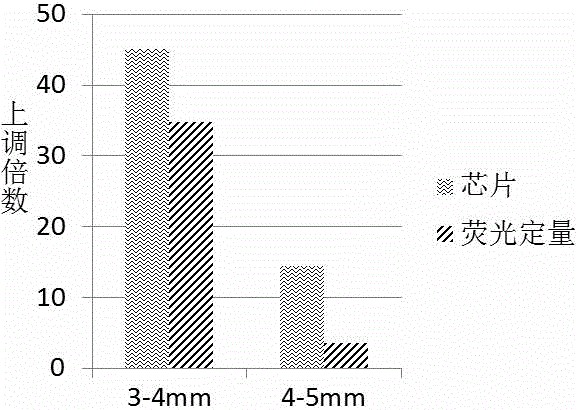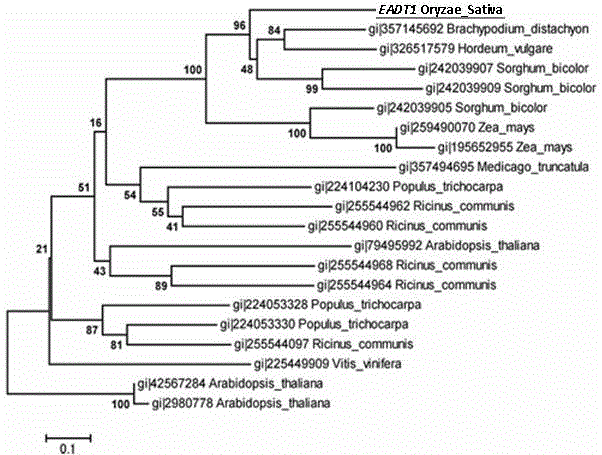EADT1 gene capable of improving drought resistance of rice in growth period, coding sequence and application
A drought resistance and rice technology, applied in the fields of genetic engineering and molecular biology, can solve the problem of no transfer of lipids, and achieve great application value, increase growth, and improve plant stress resistance.
- Summary
- Abstract
- Description
- Claims
- Application Information
AI Technical Summary
Problems solved by technology
Method used
Image
Examples
Embodiment 1
[0042] Example 1 rice under drought treatment EADT1 Identification of Gene Expression Levels During Reproductive Development of Rice Variety Nipponbare
[0043] 1. Coercion treatment
[0044] After the rice Nipponbare seeds germinate, move them to potting soil for cultivation, stop watering at the booting stage, and carry out drought treatment. When the soil moisture drops to about 30%, keep it for a week, and take different sizes (2~3mm, 3~4mm, Rice flowers of 4~5mm, 5~7mm) were collected and numbered respectively, and the rice under normal growth conditions was used as a control, and three repetitions were made.
[0045] 2. Gene chip and fluorescent quantitative PCR analysis of gene expression under drought conditions
[0046] Analysis of gene expression in rice under drought conditions using Agilent's Rice Microarray. Comparing different periods of flower development under drought versus normal conditions EADT1 Gene expression in rice variety Nippon Haruka. The resul...
Embodiment 2
[0047] Example 2 rice EADT1 Cloning of gene cDNA fragments
[0048] 1. Extraction of RNA: take drought-treated rice flowers, freeze them with liquid nitrogen in a mortar, grind them into powder, add 1 ml of TRIzol reagent (Promega) into an EP tube, oscillate fully, and place at room temperature for 5 minutes. After centrifugation at 12000 rpm for 10 min at 4°C, transfer the supernatant to a new EP tube, add 200 μl of chloroform to make an emulsion, let stand at room temperature for 5 minutes, centrifuge at 12000 rpm for 10 min, and transfer the supernatant to a new EP tube, Add twice the volume of isopropanol to precipitate RNA, centrifuge, dissolve the precipitate in water after drying, and then measure the RNA content on a spectrophotometer.
[0049] 2. Reverse transcription: according to TaKaRa's PrimeScript TM Reverse Transcriptase instructions for operation: add 5 μl (5 μg) of rice total RNA to the centrifuge tube, Oligo(dT) 15 Add 1 μl of Primer (50 μmol / L), 1 μl ...
Embodiment 3
[0053] Example 3 rice EADT1 sequence information and homology analysis
[0054] EADT1 The length of the coding region of the gene is 348bp, and its sequence is shown in SEQ ID NO.2. The amino acid sequence of rice EADT1 was deduced according to the full-length cDNA, with a total of 115 amino acid residues, a molecular weight of 12223.1 Daltons, and an isoelectric point (pI) of 5.67. The sequence is shown in SEQ NO.3. Bioinformatics analysis showed that the protein was an unstable hydrophobic protein.
[0055] Perform BLAST comparison of this protein in GenBank to obtain the protein sequence homologous to this protein, use Clustal X software for comparison, and then use MEGA5 software to construct a phylogenetic tree according to the proximity method ( figure 2 ).
PUM
| Property | Measurement | Unit |
|---|---|---|
| Molecular weight | aaaaa | aaaaa |
Abstract
Description
Claims
Application Information
 Login to View More
Login to View More - R&D
- Intellectual Property
- Life Sciences
- Materials
- Tech Scout
- Unparalleled Data Quality
- Higher Quality Content
- 60% Fewer Hallucinations
Browse by: Latest US Patents, China's latest patents, Technical Efficacy Thesaurus, Application Domain, Technology Topic, Popular Technical Reports.
© 2025 PatSnap. All rights reserved.Legal|Privacy policy|Modern Slavery Act Transparency Statement|Sitemap|About US| Contact US: help@patsnap.com



